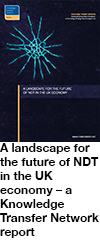NDT technology development and validation: a systematic approach
04/06/2015
Technology development was defined in the 2014 report ‘A landscape for the future of NDT in the UK economy’ as one of the key enabling actions for securing an altogether brighter future for the NDT industry. Investment and collaboration are of paramount importance to take new NDT technologies to the next level. The vital element is to ensure the technologies being developed meet the current and future needs of the user groups.
In 2003, the UK Research Centre of Non-Destructive Evaluation (RCNDE) was established, aided by sponsorship from the Engineering and Physical Sciences Research Council. This brought together industry and academia, resulting in a defined vision of the future needs, which is currently being worked through. It is this collaboration that has made the RCNDE a world-leading centre of excellence in NDT research.
This cooperation has transformed the relationship between the academic groups and the users, and as materials and processes are continuously developing there will be a similar flow of NDE technologies needed to support their use, especially in the high-value manufacturing sector. This will bring the understanding needed to define the new NDT technologies.
To be able to use NDT in practice, the techniques’ capabilities and limitations (validation) must be understood, as well as the training requirements for the inspectors. The high cost of validation, due to the need for realistic testing facilities and flaws, limits the easy flow of the new technologies into common use. In recent years, the many validations that have been undertaken are often confined to specific large projects, making it difficult to maximise any wider exploitation. Keith Newton, Director of RCNDE and co-editor of the Landscape report, said: “Often, the biggest barrier to getting a new technology released is the technology transfer stage, which can be very expensive; it can be more expensive than the research itself to validate techniques and to get the technology into a commercial state. As the report says, there are quite a lot of issues around that. Because it is expensive, small companies can’t afford to do it.” A national library of samples was suggested in the report as a very desirable facility, which would enable a more systematic approach to the validation process.
A ‘national defect centre’ would help to significantly reduce the cost of developing and testing new NDT technologies. It would be an accurate testing ground for the new techniques, using components with authentic defects. This would not only speed up the validation process but would significantly reduce costs, opening doors for developers and their supply chains, who traditionally would not have had the funds.
The 20-year vision detailed in the Landscape report is an opportunity to foresee possible developments in NDT technology that could eliminate the current obstacles in testing and evaluation. It encourages industry to work together to find varying uses for existing technology, ultimately cutting time and costs. Immediate Past President of BINDT, Tony Dunhill, said: “Most of the large companies who rely on NDT have a very clear view as to what their NDT requirements are going to be in five, ten and 20 years’ time. Through the research centre, we provided that vision to our academic collaborators and they are working on technology that meets those needs. This is quite a rare collaboration, with so many diverse industries having the same requirements. We now have the involvement of various sectors and that attracts support to the NDT industry. If we can get good technologies into companies in the UK, performing the inspections our companies want, other groups from around the world will inevitably want the same thing. So, although we are currently trying to satisfy the need within the UK, it is a world market.”
These outcomes are supporting the economy by accelerating industrial growth, feeding into the industry life-cycle that encompasses the need for an increase in skilled NDT workers and new NDE technologies, as well as advancements in current technologies and structural integrity.
For more information and to view the full report, visit www.bindt.org/downloads/Materials-KTN-Future-of-NDT-in-UK-economy.pdf